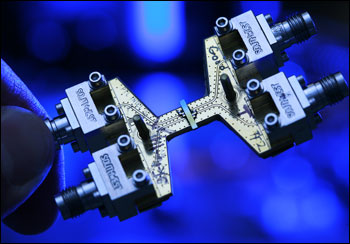
Intel Unveils 40 Gb/s Chip
SANTA CLARA, Calif., July 25, 2007 -- A laser modulator that encodes optical data at 40 Gb/s -- a significant increase in speed -- was unveiled Tuesday by Intel researchers.
A photonic integrated circuit (PIC) could provide a cost-effective solution for optical communication and optical interconnects in the computing industry -- in the future, said Ansheng Liu, principal engineer at Intel's Photonics Technology Labs, in a blog post on the company's Web site.

The 40 Gb/s silicon laser modulator chip mounted on a high-speed package for testing (Photo: Intel Corp., 2007)
"We have finally reached the goal of data transmission at 40 Gb/s speed, matching the fastest devices deployed today using other materials," he said. "With the demonstration of the 40 Gb/s silicon modulator and the electrically pumped hybrid silicon laser, it will become possible to integrate multiple devices on a single chip that can transmit terabits of aggregate data per second in the near future -- truly enabling terascale computing."
PICs on silicon platforms have attracted particular interest because of silicon’s low cost and high-volume manufacturability, Liu said. "Competition in this arena is intense, as many players in both academia and industry have been aggressively pursuing research into completely integrated CMOS photonics."
The Electronic & Photonic Integrated Circuits (EPIC) program initiated by the Defense Advanced Research Projects Agency has also been supporting several Universities and startups to develop capabilities in this area.
"A key component needed for silicon PICs is the high-speed silicon optical modulator, which is used to encode data on optical beam," Liu said. Today’s commercially available optical modulators at 10 Gb/s are based on more exotic electro-optic materials such as lithium niobate and III-V compound semiconductors. These devices have deployed at speeds up to 40 Gb/s.

Ansheng Liu, principal engineer and optical architect for Intel's Photonics Technology Labs, holds a packaged 40 Gb/s silicon laser modulator.(Photo: Intel Corp., 2007)
"Our goal to achieve similar performance in silicon has been very challenging, because crystalline silicon does not exhibit the linear electro-optic (Pockels) effect used to modulate light in these materials," he said. "Engineers are forced to rely on the free-carrier plasma dispersion effect, in which silicon’s refractive index is changed when the density of free carriers (electrons/holes) is varied, to modulate light in silicon."
In 2004, Intel published reserach on the first silicon modular to reach gigahertz speeds -- 50X times faster than previous attempts in silicon. Since then, it has scaled the device to 10 Gb/s, brining silicon modulation speed to a level comparable to most commercial devices.
In January 2007, the company designed and fabricated a new type of silicon optical modulator scalable to >>10 Gb/s and demonstrated data transmission at 30 Gb/s. The modulator still relies on the free-carrier effect, but its high speed is the result of a unique device design with traveling-wave drive scheme, Liu said.
Liu presented the results in a silicon modulator to "a small group of scientists" earlier this month at Integrated Photonics and Nanophotonics Research and Applications in Salt Lake City, Utah.
The Intel modulator is based on a Mach-Zehnder interferometer with a reverse-biased p-n junction in each of the arms. When a reverse voltage is applied to the junction, free carriers -- electrons and holes resulting from the n- and p-dopants -- are pulled out of the junction, changing its refractive index via the free-carrier effect. The intensity of the light transmitted through the Mach-Zehnder interferometer is modulated by modulating the phase difference between the interferometer’s two arms.
"This modulation can be very fast, because free carriers can be swept out of the junction with a time of approximately 7 ps. The modulator speed is thus limited by the parasitic effects such as RC time constant limit," Liu said.
To minimize the RC constant limitation, Intel researchers adopted a traveling-wave drive scheme allowing electrical and optical signal co-propagation along the waveguide. The traveling-wave electrode, which is based on a coplanar waveguide, was designed to match the velocity for both optical and electrical signals, while keeping the radio frequency (RF) attenuation small.
To operate the traveling-wave modulator, the RF signal is fed into the transmission line using a commercially available driver from the optical input side, and the transmission line is terminated with an external resistor. After packaging the modulator on a printed circuit board, the researchers demonstrated that the modulator has a 3-dB bandwidth of ~30 GHz and data transmission capability up to 40 Gb/s.
For more information, visit: www.intel.com
/Buyers_Guide/Intel_Corp/c6919